Mexican holiday that honors family and friends who have passed. Is it easier for them to be with us during that time?
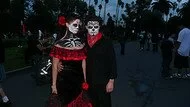 Many of us choose to believe that death separates the dead from the living, but does it really? The Day of the Dead (known as El Día de los Muertos), celebrated primarily in Mexico and other parts of Latin America, is a way to honor the spirits of the departed. Families and friends gather to remember and pray for those who have passed on. The festivities occur November 1st and 2nd in conjunction with Catholicism's All Saints' Day and All Souls' Day. In many regions of Mexico, the 1st of November is used to honor departed children and infants, while deceased adults are honored on the 2nd of November. Sometimes, adult spirits are "coaxed" out of the graves by taunting them on the second day of festivities.
Many of us choose to believe that death separates the dead from the living, but does it really? The Day of the Dead (known as El Día de los Muertos), celebrated primarily in Mexico and other parts of Latin America, is a way to honor the spirits of the departed. Families and friends gather to remember and pray for those who have passed on. The festivities occur November 1st and 2nd in conjunction with Catholicism's All Saints' Day and All Souls' Day. In many regions of Mexico, the 1st of November is used to honor departed children and infants, while deceased adults are honored on the 2nd of November. Sometimes, adult spirits are "coaxed" out of the graves by taunting them on the second day of festivities.
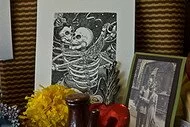 During the Day of the Dead holiday, different traditions may be witnessed. Many visit cemeteries in large numbers to honor the deceased; distribute flowers in graveyards, churches and streets to guide the souls of loved ones; while personal altars in homes honoring ancestors may be constructed displaying flowers, favorite possessions and beloved foods of the deceased. Prayers are typically offered, music may be played and candles are often kept burning in a joyful display of remembrance.
During the Day of the Dead holiday, different traditions may be witnessed. Many visit cemeteries in large numbers to honor the deceased; distribute flowers in graveyards, churches and streets to guide the souls of loved ones; while personal altars in homes honoring ancestors may be constructed displaying flowers, favorite possessions and beloved foods of the deceased. Prayers are typically offered, music may be played and candles are often kept burning in a joyful display of remembrance.
Macabre Celebrations for the Dead
Those who enjoy writing often create short poems, known as "calaveras" (skulls), written as epitaphs for the living, detailing a friend's or family member's interesting habits, often sharing funny details. This tradition began a century or two ago when a newspaper published a poem describing a dream of a cemetery in the future. In the poem, everyone was dead and the writing on tombstones was quite humorous. Today, newspapers continue to write calaveras concerning public figures, typically illustrated with skeletons.
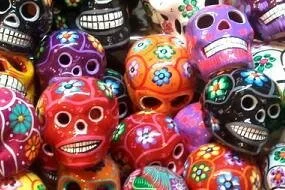 The common symbol of the Day of the Dead is the skull (calavera), which may be seen decorated and worn as masks (calacas - "skeleton"). Even foods may be shaped into skulls, such as chocolate candy with the name of the person written upon it. Skulls of sugar are often given as gifts to celebrants, as well as to unseen guests in spirit. Even bread may be found sculpted into the shape of skulls or skeletons.
The common symbol of the Day of the Dead is the skull (calavera), which may be seen decorated and worn as masks (calacas - "skeleton"). Even foods may be shaped into skulls, such as chocolate candy with the name of the person written upon it. Skulls of sugar are often given as gifts to celebrants, as well as to unseen guests in spirit. Even bread may be found sculpted into the shape of skulls or skeletons.
Day of the Dead traditions and festivities often vary, so different ways to honor the dead can be found from town to town. One never knows what seemingly macabre scene may be discovered. It's said that in some cities, children in costume may be seen roaming the streets and knocking on people's doors. This tradition is very similar to Halloween's Trick or Treat night custom, as often a small prize of candy or money may be collected.
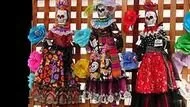 Macabre dolls and other strange items may be carried around by those who celebrate the Day of the Dead in the belief that such a custom might bring good luck. The Day of the Dead celebration is really a time to remember all people, no matter which side of the grave they are on. And if we think about it, such a festivity is a fun way to remember that we do indeed have ghosts and spirits walking among us.
Macabre dolls and other strange items may be carried around by those who celebrate the Day of the Dead in the belief that such a custom might bring good luck. The Day of the Dead celebration is really a time to remember all people, no matter which side of the grave they are on. And if we think about it, such a festivity is a fun way to remember that we do indeed have ghosts and spirits walking among us.
Ghosts and Spirits Among the Living
Many believe that during the short window of the Day of the Dead, it's easier for departed souls to visit the living. During this peak time, people will often visit cemeteries to communicate with departed loved ones, making them feel welcome at home by building private altars displaying items that honor their lives.
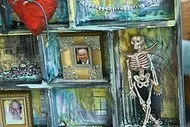 Celebrants of the Day of the Dead purposely invite visitations by spirits so that they may hear the words and actions directed toward them. Because focusing on death can be somewhat dark, Day of the Dead celebrations often interject humor and fun. While remembering loved ones, participants in festivities will often remember humorous, past scenarios involving the departed. Sometimes during Day of the Dead celebrating, people become drunk while honoring their friends and relatives. Toys may be brought out to remember dead children, while bottles of various types of alcoholic drinks may be placed on graves for adults who have passed on to enjoy. Trinkets and candies may also be left on top of headstones.
Celebrants of the Day of the Dead purposely invite visitations by spirits so that they may hear the words and actions directed toward them. Because focusing on death can be somewhat dark, Day of the Dead celebrations often interject humor and fun. While remembering loved ones, participants in festivities will often remember humorous, past scenarios involving the departed. Sometimes during Day of the Dead celebrating, people become drunk while honoring their friends and relatives. Toys may be brought out to remember dead children, while bottles of various types of alcoholic drinks may be placed on graves for adults who have passed on to enjoy. Trinkets and candies may also be left on top of headstones.
In homes, foods such as bread of the dead, candied pumpkin and sugar skulls may be displayed to honor the dead. They are left out in homes to welcome spirits and ghosts of loved ones. It is believed that spirits can enjoy the spiritual essence of food and beverages. Typically, the same offerings are also enjoyed by the living after the festivities. It's not uncommon for people to even leave spirits places to sleep (after their long journey to visit friends and family), complete with pillows and blankets. The Day of the Dead is truly a celebration of oneness and love for those who are with us, yet remain unseen.
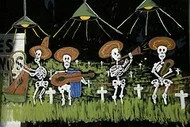 The Day of the Dead holiday is very important to Mexican heritage. Celebrations of the dead in Mexico can be traced back to the indigenous peoples of the region, such as the Olmec, Zapotec, Mixtec, Aztec, and Mayan cultures. Such rituals that celebrate spirit ancestors have been carried out by these civilizations for maybe 2500–3000 years. It is also rooted in Catholic traditions, something important that has also helped to make the beliefs what they are today. We can take something away from the Day of the Dead celebration: death may not be as permanent as some might believe it to be.
The Day of the Dead holiday is very important to Mexican heritage. Celebrations of the dead in Mexico can be traced back to the indigenous peoples of the region, such as the Olmec, Zapotec, Mixtec, Aztec, and Mayan cultures. Such rituals that celebrate spirit ancestors have been carried out by these civilizations for maybe 2500–3000 years. It is also rooted in Catholic traditions, something important that has also helped to make the beliefs what they are today. We can take something away from the Day of the Dead celebration: death may not be as permanent as some might believe it to be.

